1. The Welcome to Fabulous Las Vegas Sign – Las Vegas, Nevada
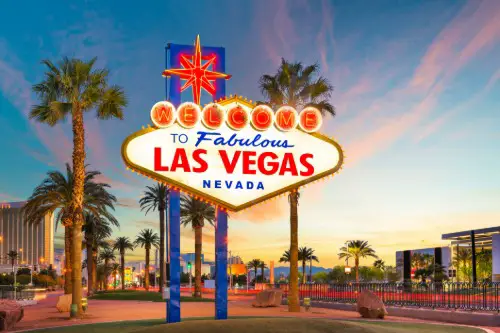
You can’t talk iconic roadside signs without starting with this glittering gateway to Sin City. Designed by Betty Willis in 1959, the “Welcome to Fabulous Las Vegas” sign is arguably more famous than some of the casinos it heralds, according to Visit Las Vegas. It’s never been moved from its perch on Las Vegas Boulevard, even as the Strip has exploded around it. People line up daily to snap selfies here, and honestly, it’s kind of a rite of passage.
What makes it legendary is how perfectly it captures the spirit of Vegas—retro glam, neon glow, and a wink at showbiz. The sign’s design reflects the postwar optimism and atomic age vibes of the era. Even though it’s technically just outside the city limits, it’s the unofficial start of the Vegas experience. Betty Willis, by the way, never copyrighted it—she considered it her gift to the city.
2. The Hollywood Sign – Los Angeles, California

OK, so this one started as an ad, according to Lois Beckett from The Guardian, but it’s become the stuff of dreams (and movie montages). Originally erected in 1923 as “Hollywoodland” to promote a housing development, it was only supposed to last 18 months. Spoiler alert: it didn’t go anywhere. Over the decades, it’s been rebuilt, restored, and guarded like Fort Knox to preserve its star status.
While it’s not exactly roadside anymore, you can spot it from all over L.A. while cruising the freeway. It’s now a global symbol of fame, fantasy, and maybe a little heartbreak. Every time it shows up in a film or Instagram story, it reminds us why people still flock to Hollywood chasing stardust. And yes, it really does look that cool in person.
3. The Big Texan Steak Ranch Sign – Amarillo, Texas

If you’re driving I-40 through Texas and see a massive cowboy pointing you toward a 72-ounce steak challenge, you’ve just met Big Tex, Mirya Dila from Texas Monthly shares. This larger-than-life sign beckons travelers to the Big Texan Steak Ranch, where brave souls try to eat an entire four-and-a-half-pound steak dinner in under an hour. It’s not just a sign—it’s a dare. And it’s been luring hungry road warriors since the 1960s.
The sign’s cartoony cowboy and flashing lights feel like a throwback to Route 66’s golden era. People may stop for the gimmick, but they stay for the sheer spectacle (and maybe to watch someone fail the challenge). Big Tex is one of those icons that manages to be both absurd and deeply American. Plus, you’ve gotta love a roadside sign that doubles as a warning label for meat sweats.
4. Wall Drug Billboards – South Dakota
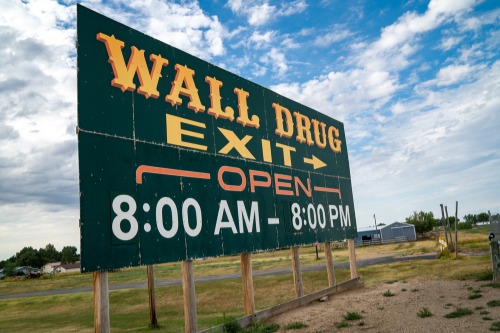
You haven’t really done a road trip through the Midwest unless you’ve spotted a Wall Drug sign, Ethan Jakob Craft from Ad Age explains. These hand-painted, often cheeky billboards stretch for hundreds of miles, offering free ice water and old-school fun. The first one went up in the 1930s, and now they’re practically a breadcrumb trail to the main attraction in Wall, South Dakota. The signs are part humor, part nostalgia, and 100% roadside marketing genius.
Wall Drug started as a tiny pharmacy, and its founder, Ted Hustead, hit gold when he realized hot, tired travelers on U.S. 16 would stop for free water. The billboards are now global—there’s even one in Kenya, just for kicks. But it’s the ones along the highway that really strike a chord, because they turn a long drive into an adventure. When you finally arrive, it’s like meeting a celebrity after months of reading their tweets.
5. The Wigwam Motel Signs – Holbrook, Arizona and San Bernardino, California
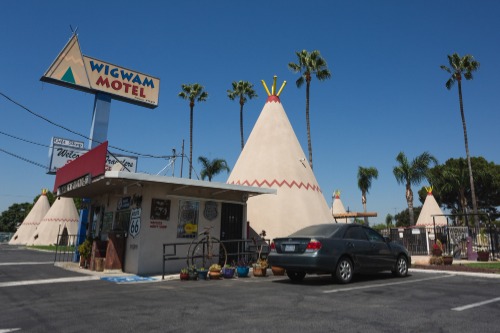
It’s hard not to smile when you see a giant neon teepee glowing along Route 66. The Wigwam Motel signs are quirky, vintage Americana at its finest. There were originally seven of these kitschy motels across the U.S., built in the 1930s through 1950s, and only three remain today. Two are still on the Mother Road, which just adds to their mystique.
The signs themselves are classic mid-century neon, with arrows, bold lettering, and stylized imagery that feel like a time warp. They’re not just signs—they’re promises of weird and wonderful roadside sleepovers. If the motels look familiar, it might be because they inspired the Cozy Cone Motel in Pixar’s Cars. Staying in one is like checking into a living postcard.
6. South of the Border – Dillon, South Carolina
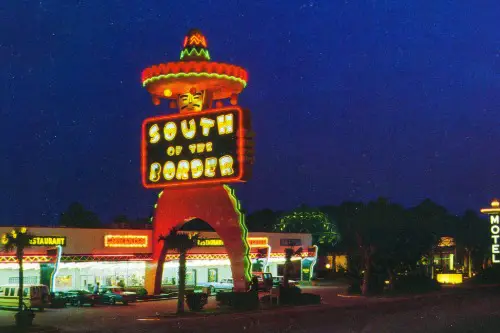
You might not know where Dillon, South Carolina is, but if you’ve ever driven I-95, you definitely know South of the Border. This sprawling rest stop/theme park/fever dream is home to hundreds of garish signs featuring a mustachioed mascot named Pedro. They start appearing up to 100 miles out and hit you with pun after pun. “You never sausage a place!” and “Pedro’s weather report: Chili today, hot tamale!”
It started in the 1950s and has grown into a full-on roadside spectacle with fireworks, a reptile lagoon, and a sombrero-shaped tower. While the signs have drawn criticism for stereotyping, they’ve also become camp icons. Love it or hate it, the branding is unforgettable—and you’ll probably stop, if only to figure out what the heck it is. And that’s exactly why it works.
7. The Route 66 Shield Markers – Various States
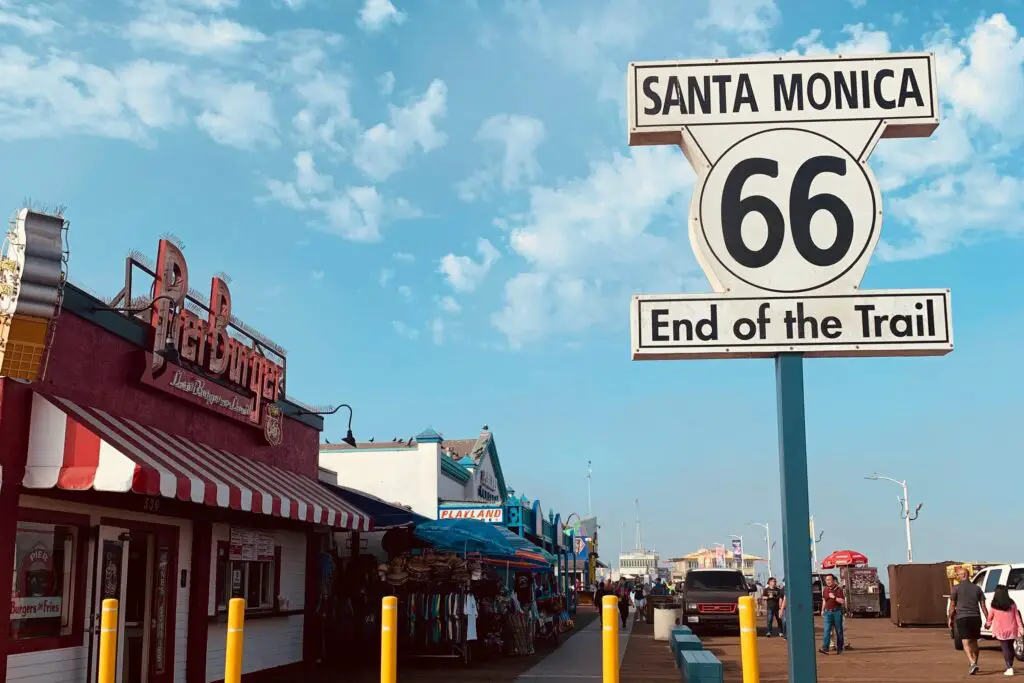
You don’t always need a giant neon sign to make an impact—sometimes a painted highway shield is all it takes. The Route 66 markers on the road itself are simple white-and-black emblems, but they’re instantly recognizable and deeply symbolic. This route connected Chicago to Santa Monica and became the backdrop for generations of American wanderlust. Drivers often pull over just to take photos of the painted logos on the pavement.
These signs mark not just a road, but a vibe—a love letter to exploration, diners, and roadside motels. As pieces of history, they anchor the modern traveler to something bigger than GPS coordinates. Route 66 might not be an official highway anymore, but the signage keeps it alive in our collective imagination. If you’ve ever gotten a little misty-eyed taking a picture of one, you’re definitely not alone.
8. Paul Bunyan and Babe the Blue Ox – Bemidji, Minnesota

When you pull into Bemidji, Minnesota, and see a towering lumberjack and his giant blue ox, it’s impossible not to smile. This iconic duo was built in 1937 to attract tourists, and boy, did it work. At 18 feet tall (Paul) and 10 feet tall (Babe), they’re basically the OGs of photo ops. The sign isn’t neon or flashy—it’s good old-fashioned roadside charm.
The statue-sign hybrid pays homage to American folklore and the logging history of the region. Over the years, it’s become one of the most photographed roadside attractions in the country. Locals even claim it’s the second-most photographed statue in the U.S., after Mount Rushmore. Whether or not that’s true, it’s earned its legendary status through pure staying power.
9. The Googie Arrows of Mel’s Drive-In – Los Angeles, California
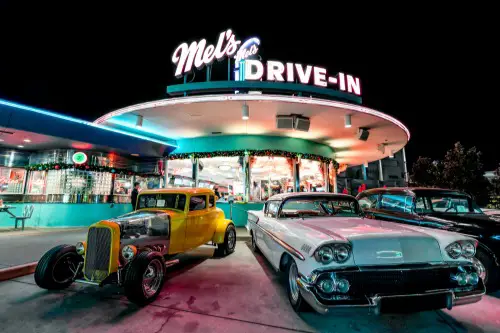
Mel’s Drive-In in L.A. isn’t just a diner—it’s a design landmark. The neon sign out front is all swooping arrows, atomic shapes, and space-age flair, a prime example of Googie architecture. Popularized in the 1950s and ’60s, Googie style was all about bold colors and exaggerated shapes, and Mel’s nails it. You can practically hear a rockabilly tune just looking at it.
Mel’s was originally a San Francisco chain, but the Hollywood location made the aesthetic famous again. It’s been in movies, music videos, and a million Instagram stories. People don’t just come for burgers and shakes—they come for a bite of mid-century cool. The sign alone feels like a time machine with fries.
10. The Blue Whale of Catoosa – Catoosa, Oklahoma
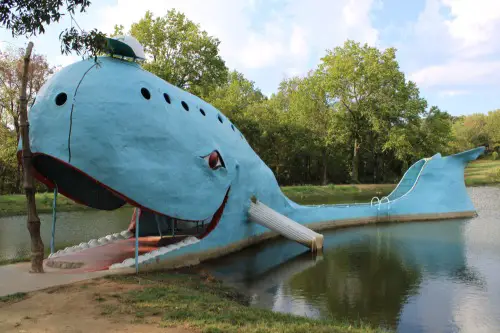
This one isn’t just a sign—it’s a full-on roadside mascot. The Blue Whale of Catoosa, built in the early ’70s, was originally a swimming hole gift from a dad to his wife. But soon, travelers along Route 66 started pulling over for photos with the smiling sea creature. A small wooden sign welcomes visitors, but it’s the whale’s massive, cartoonish grin that does the real advertising.
Though the attraction fell into disrepair in the ’80s, the local community lovingly restored it. Now it’s one of the most beloved (and weirdest) stops along the Mother Road. The whale has even inspired local festivals and roadside souvenirs. It’s proof that a great roadside sign doesn’t have to be neon—it just has to have heart.
11. The Giant Chicken at Big Chicken – Marietta, Georgia
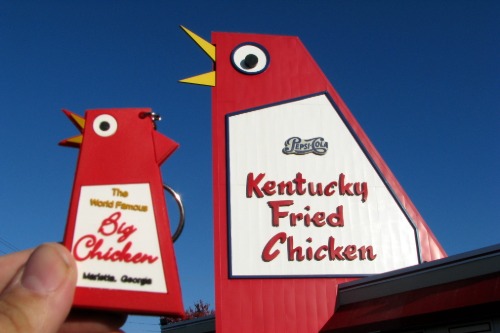
If you’re driving through Marietta, Georgia, and a 56-foot-tall chicken with rolling eyes appears on the horizon, don’t panic. That’s just the Big Chicken, the sign for a KFC that’s been guiding locals and pilots since 1963. It’s so iconic that when it was nearly torn down in the ’90s, locals fought to save it—and won. Even Delta pilots reportedly use it as a visual landmark for landing approaches into Atlanta.
It’s absurd, yes, but also totally charming. The chicken’s beak even moves, which adds just the right amount of weird to your fast-food stop. It’s one of the few roadside signs that’s become a navigational reference point. And let’s be honest—how many fried chicken places can say that?
12. Tee Pee Curios – Tucumcari, New Mexico

Tee Pee Curios isn’t a chain, a gimmick, or a giant attraction—it’s a single gift shop with one of the coolest signs on Route 66. The whole building is shaped like a teepee, with a neon sign spelling out “Curios” in cowboy-style lettering. Built in the 1940s as a gas station, it shifted to souvenirs when fuel sales dipped, and the sign remained a beacon. Today, it’s one of the most photographed stops in Tucumcari.
The sign glows pink and green at night, perfectly framing the concrete teepee below. It’s kitschy, yes, but it’s also part of Route 66’s legacy of independent, family-run businesses. There’s something magical about how much personality is packed into such a small spot. You don’t just see it—you feel it.
13. Cadillac Ranch – Amarillo, Texas
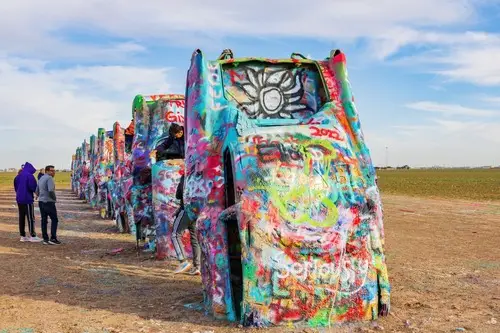
Cadillac Ranch isn’t a traditional sign, but it’s definitely a message. This public art installation features 10 Cadillacs buried nose-down in the Texas dirt, tail fins jutting into the sky. Created in 1974 by the art collective Ant Farm, it’s a weird, wonderful symbol of freedom and roadside rebellion. People come from all over the world to spray paint the cars—yes, that’s encouraged.
Though there’s no neon or marquee, the cars themselves act like a giant invitation. They’re visible from I-40, and the unofficial signs nearby direct you toward the field. It’s one part sculpture, one part performance art, and all parts road trip legend. If you miss it, you kind of miss the whole point of roadside Americana.


